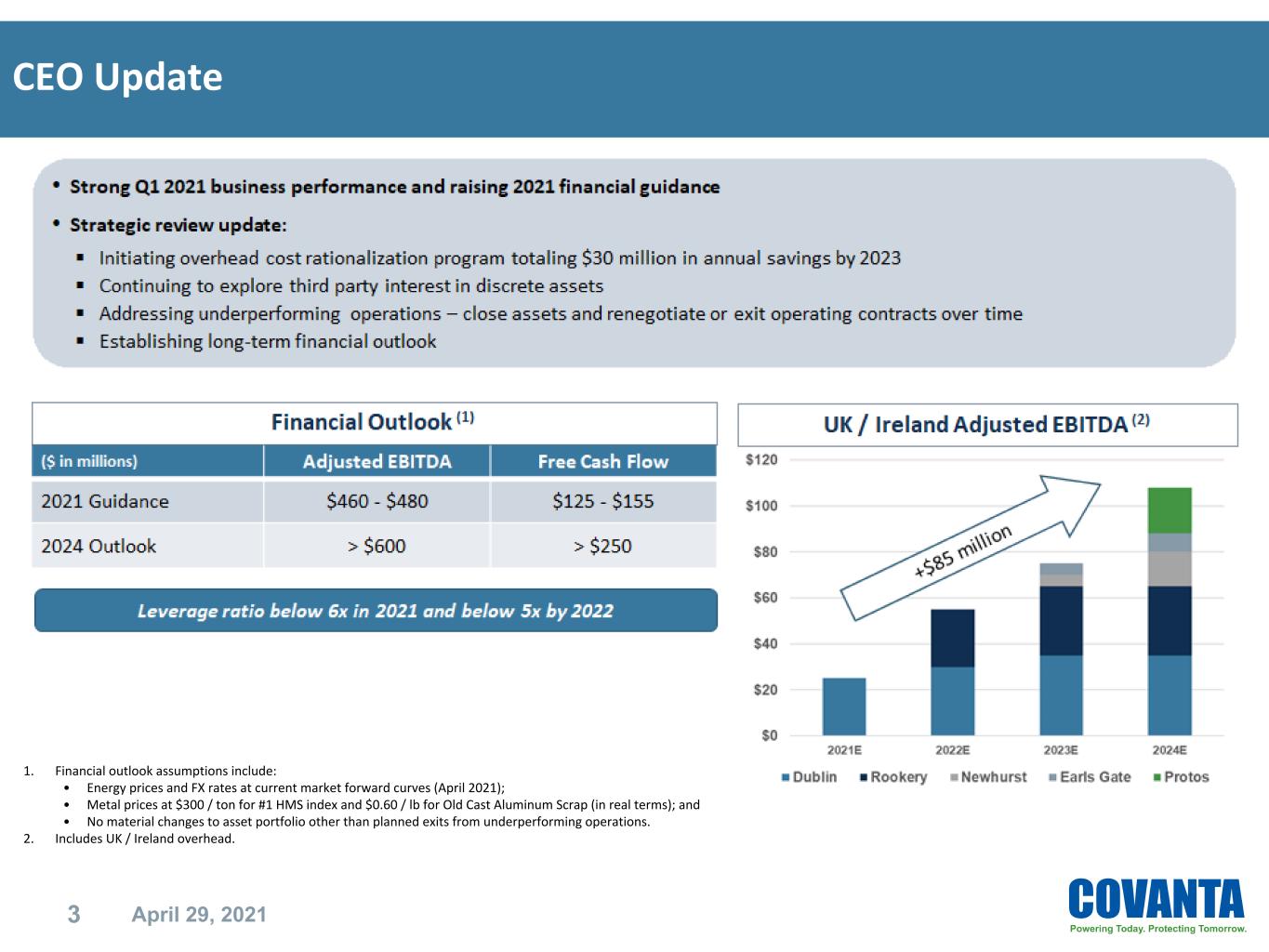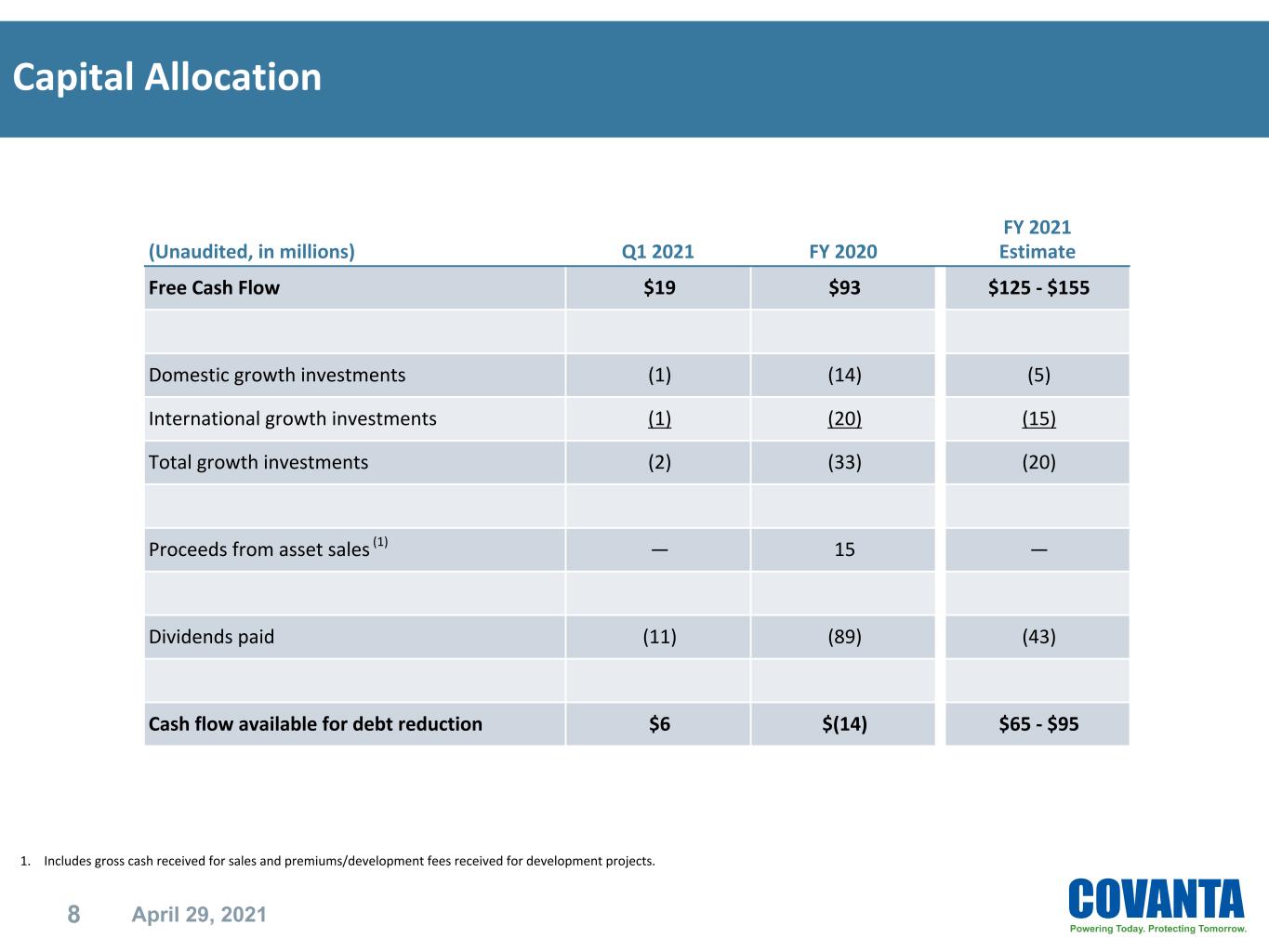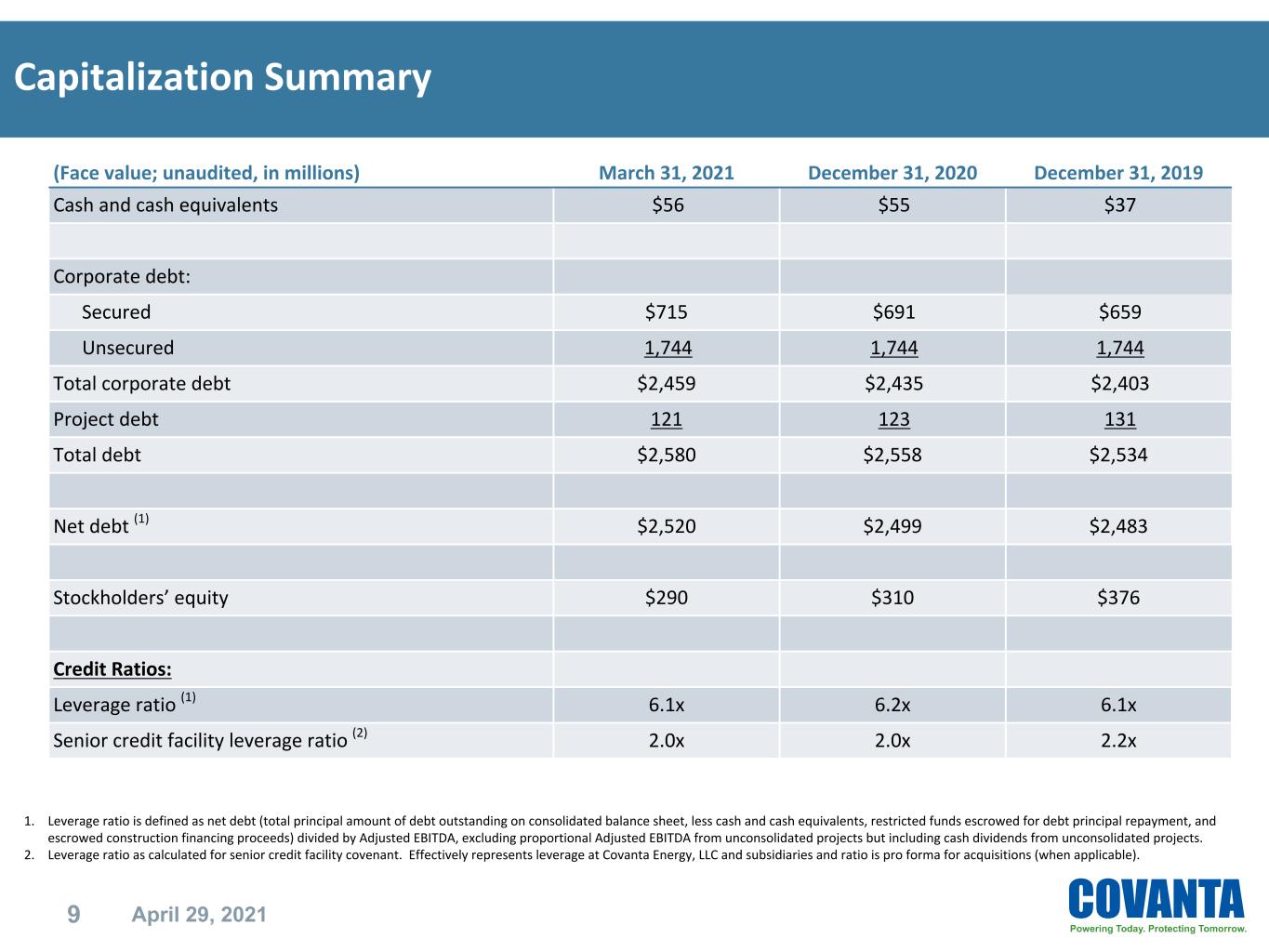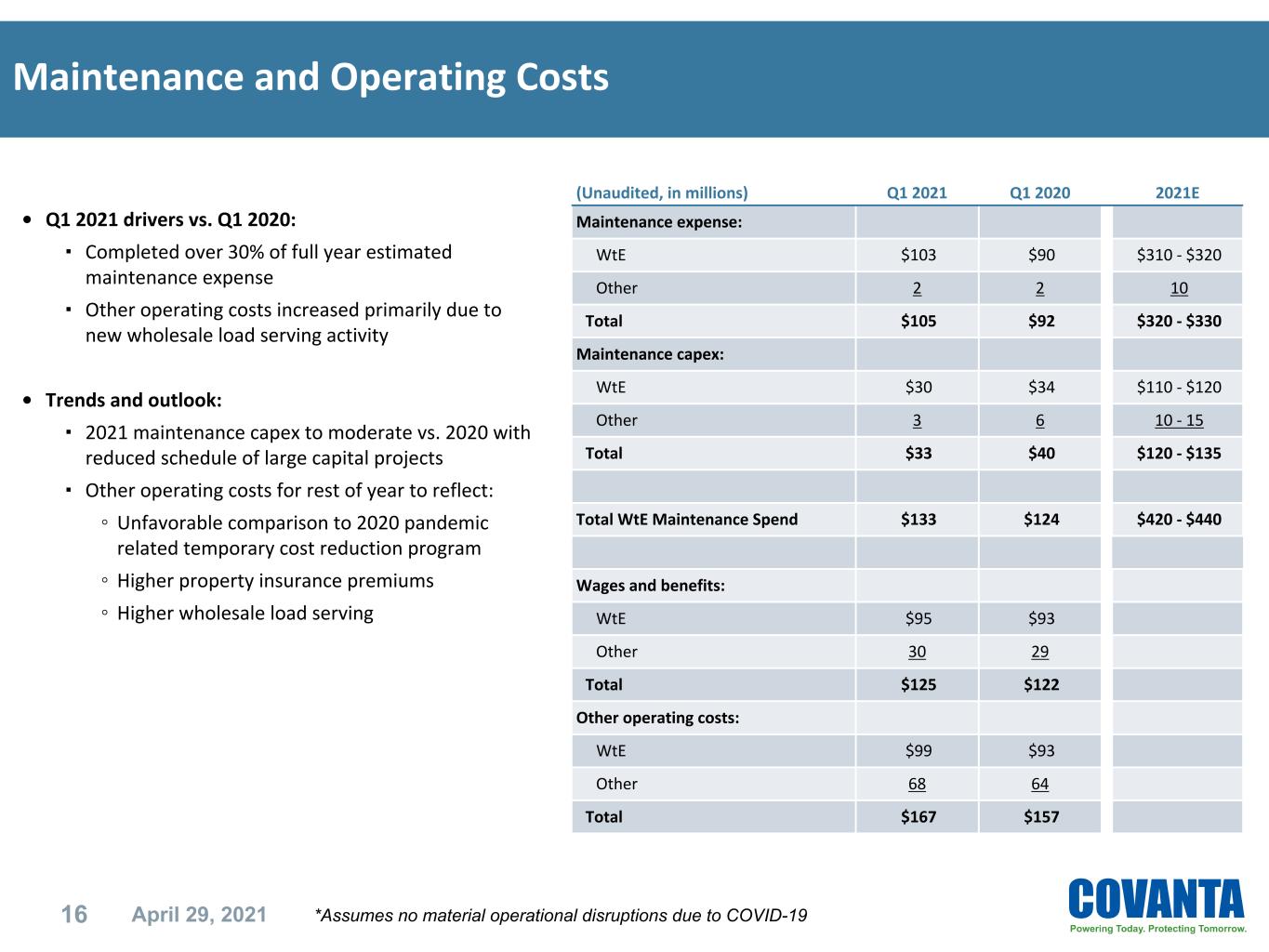Attached files
| file | filename |
|---|---|
| 8-K - 8-K - COVANTA HOLDING CORP | cva-20210429.htm |
| EX-99.1 - EX-99.1 - COVANTA HOLDING CORP | exhibit991q121.htm |

NYSE: CVA April 29, 2021 First Quarter 2021 Earnings Conference Call

April 29, 2021 2 Cautionary Statements All information included in this earnings presentation is based on continuing operations, unless otherwise noted. Forward-Looking Statements Certain statements in this press release may constitute “forward-looking” statements as defined in Section 27A of the Securities Act of 1933 (the “Securities Act”), Section 21E of the Securities Exchange Act of 1934 (the “Exchange Act”), the Private Securities Litigation Reform Act of 1995 (the “PSLRA”) or in releases made by the Securities and Exchange Commission (“SEC”), all as may be amended from time to time. Such forward-looking statements involve known and unknown risks, uncertainties and other important factors that could cause the actual results, performance or achievements of Covanta Holding Corporation and its subsidiaries (“Covanta”) or industry results, to differ materially from any future results, performance or achievements expressed or implied by such forward-looking statements. Statements that are not historical fact are forward-looking statements. Forward-looking statements can be identified by, among other things, the use of forward-looking language, such as the words “plan,” “believe,” “expect,” “anticipate,” “intend,” “estimate,” “project,” “may,” “will,” “would,” “could,” “should,” “seeks,” or “scheduled to,” or other similar words, or the negative of these terms or other variations of these terms or comparable language, or by discussion of strategy or intentions. These cautionary statements are being made pursuant to the Securities Act, the Exchange Act and the PSLRA with the intention of obtaining the benefits of the “safe harbor” provisions of such laws. Covanta cautions investors that any forward-looking statements made by us are not guarantees or indicative of future performance. Important factors, risks and uncertainties that could cause actual results to differ materially from those forward-looking statements include, but are not limited to: the impact of the COVID-19 pandemic on our employees, business, and operations, or on the economy in general, including commercial and financial markets; our ability to identify opportunities and execute on strategies and transactions, including in connection with a strategic review of our business and including acquisitions, divestitures, and restructuring opportunities; seasonal or long-term fluctuations in the prices of energy, waste disposal, scrap metal and commodities; our ability to renew or replace expiring contracts at comparable prices and with other acceptable terms; adoption of new laws and regulations in the United States and abroad, including energy laws, environmental laws, tax laws, labor laws and healthcare laws; failure to maintain historical performance levels at our facilities and our ability to retain the rights to operate facilities we do not own; our ability to avoid adverse publicity or reputational damage relating to our business; advances in technology; difficulties in the operation of our facilities, including fuel supply and energy delivery interruptions, failure to obtain regulatory approvals, equipment failures, labor disputes and work stoppages, and weather interference and catastrophic events; difficulties in the financing, development and construction of new projects and expansions, including increased construction costs and delays; our ability to realize the benefits of long-term business development and bear the cost of business development over time; limits of insurance coverage; our ability to avoid defaults under our long-term contracts; performance of third parties under our contracts and such third parties' observance of laws and regulations; concentration of suppliers and customers; geographic concentration of facilities; increased competitiveness in the energy and waste industries; changes in foreign currency exchange rates; limitations imposed by our existing indebtedness, including limitations on strategic alternatives or transactions; our ability to perform our financial obligations and guarantees and to refinance our existing indebtedness; exposure to counterparty credit risk and instability of financial institutions in connection with financing transactions; the scalability of our business; our ability to attract and retain talented people; failures of disclosure controls and procedures and internal controls over financial reporting; our ability to utilize net operating loss carryforwards; general economic conditions in the United States and abroad, including the availability of credit and debt financing; and other risks and uncertainties affecting our business described in Item 1A. Risk Factors of our Annual Report on Form 10-K and in other filings by Covanta with the SEC. Although Covanta believes that its plans, cost estimates, returns on investments, intentions and expectations reflected in or suggested by such forward-looking statements are reasonable, actual results could differ materially from a projection or assumption in any forward-looking statements. Covanta's and the joint ventures future financial condition and results of operations, as well as any forward-looking statements, are subject to change and to inherent risks and uncertainties. The forward-looking statements contained in this press release are made only as of the date hereof and Covanta does not have, or undertake, any obligation to update or revise any forward-looking statements whether as a result of new information, subsequent events or otherwise, unless otherwise required by law. Note: All estimates with respect to future periods are as of April 29, 2021. Covanta does not have or undertake any obligation to update or revise any forward-looking statements whether as a result of new information, subsequent events or otherwise, unless otherwise required by law. Discussion of Non-GAAP Financial Measures We use a number of different financial measures, both United States generally accepted accounting principles (“GAAP”) and non-GAAP, in assessing the overall performance of our business. To supplement our assessment of results prepared in accordance with GAAP, we use the measures of Adjusted EBITDA and Free Cash Flow which are non-GAAP measures as defined by the Securities and Exchange Commission. The non-GAAP financial measures of Adjusted EBITDA and Free Cash Flow as described below, and used in this release, are not intended as a substitute or as an alternative to net income or cash flow provided by operating activities as indicators of our performance or liquidity or any other measures of performance or liquidity derived in accordance with GAAP. In addition, our non-GAAP financial measures may be different from non-GAAP measures used by other companies, limiting their usefulness for comparison purposes. The presentations of Adjusted EBITDA and Free Cash Flow are intended to enhance the usefulness of our financial information by providing measures which management internally use to assess and evaluate the overall performance of its business and those of possible acquisition or divestiture candidates, and highlight trends in the overall business. Note: Throughout this presentation, certain amounts may not total due to rounding.

April 29, 2021 3 CEO Update 1. Financial outlook assumptions include: • Energy prices and FX rates at current market forward curves (April 2021); • Metal prices at $300 / ton for #1 HMS index and $0.60 / lb for Old Cast Aluminum Scrap (in real terms); and • No material changes to asset portfolio other than planned exits from underperforming operations. 2. Includes UK / Ireland overhead.

April 29, 2021 4 Operations and Markets Update

April 29, 2021 5 Revenue: Q1 2021 vs. Q1 2020 1. Tip fee waste tons received and energy and metals sold. (Unaudited) (1)

April 29, 2021 6 Adjusted EBITDA: Q1 2021 vs. Q1 2020 (Unaudited) (1) 1. Tip fee waste tons received and energy and metals sold.

April 29, 2021 7 Free Cash Flow: Q1 2021 vs. Q1 2020 1. Includes capital type expenditures at client owned facilities. (Unaudited) (1)

April 29, 2021 8 Capital Allocation (Unaudited, in millions) Q1 2021 FY 2020 FY 2021 Estimate Free Cash Flow $19 $93 $125 - $155 Domestic growth investments (1) (14) (5) International growth investments (1) (20) (15) Total growth investments (2) (33) (20) Proceeds from asset sales (1) — 15 — Dividends paid (11) (89) (43) Cash flow available for debt reduction $6 $(14) $65 - $95 1. Includes gross cash received for sales and premiums/development fees received for development projects.

April 29, 2021 9 (Face value; unaudited, in millions) March 31, 2021 December 31, 2020 December 31, 2019 Cash and cash equivalents $56 $55 $37 Corporate debt: Secured $715 $691 $659 Unsecured 1,744 1,744 1,744 Total corporate debt $2,459 $2,435 $2,403 Project debt 121 123 131 Total debt $2,580 $2,558 $2,534 Net debt (1) $2,520 $2,499 $2,483 Stockholders’ equity $290 $310 $376 Credit Ratios: Leverage ratio (1) 6.1x 6.2x 6.1x Senior credit facility leverage ratio (2) 2.0x 2.0x 2.2x Capitalization Summary 1. Leverage ratio is defined as net debt (total principal amount of debt outstanding on consolidated balance sheet, less cash and cash equivalents, restricted funds escrowed for debt principal repayment, and escrowed construction financing proceeds) divided by Adjusted EBITDA, excluding proportional Adjusted EBITDA from unconsolidated projects but including cash dividends from unconsolidated projects. 2. Leverage ratio as calculated for senior credit facility covenant. Effectively represents leverage at Covanta Energy, LLC and subsidiaries and ratio is pro forma for acquisitions (when applicable).

April 29, 2021 10 Appendix

April 29, 2021 11 UK / Ireland Project Update Notes: Investment schedule and financial outlook based on current forward curve for foreign exchange rates. Proportional, unconsolidated, non-recourse project debt to total ~$650 million representing debt balance at Dublin of $213 million at 3/31/21 plus projected fully funded amounts to complete construction of UK projects.

April 29, 2021 12 • Q1 2021 revenue drivers vs. Q1 2020: ▪ Same store WtE tip fee revenue: ◦ Price up $6 million (4%) ◦ Volume down $8 million (5%) due to planned maintenance activity ◦ WtE profiled waste revenue down by 8% vs. strong Q1 2020, but set record in March ▪ Service fee revenue up $4 million (3%) • Trends and outlook: ▪ 3% to 5% same store WtE tip fee price growth ◦ Re-contracting activity to benefit from market tightness in key regions ◦ Better mix from stabilization of economy and profiled waste growth ▪ Service fee revenue to improve from increased client waste processed vs. 2020 Waste Update (Unaudited; in millions, except price) Q1 2021 Q1 2020 2021E Waste Revenue: Tip fees $159 $161 $675 - $700 Service fees 123 119 485 - 495 Waste to energy processing $282 $279 $1,155 - $1,190 Materials processing and recycling 25 22 100 - 105 Waste handling and disposal 67 67 285 Intercompany (30) (28) (125) Total $343 $340 $1,420 - $1,460 WtE Tons: (1) Tip fees contracted 2.0 2.1 8.8 - 8.9 Tip fees uncontracted 0.6 0.6 1.9 - 2.0 Service fees 2.5 2.6 10.5 - 10.6 Total 5.1 5.3 21.2 - 21.5 WtE Tip Fees Revenue/Ton: Contracted $57.22 $54.04 Uncontracted $80.24 $82.87 Average Tip Fees $62.54 $60.36 $63.00 - $64.00 1. Excludes liquid waste. *Assumes no material operational disruptions due to COVID-19

April 29, 2021 13 Energy Update (Unaudited; in millions, except price) Q1 2021 Q1 2020 2021E Energy revenue: Energy sales $76 $77 $255 - $275 Capacity 10 10 40 Wholesale load serving (1) 11 4 55 RECs and other 7 2 25 Total $104 $93 $375 - $395 MWh Sold: Contracted 0.5 0.5 2.0 - 2.1 Hedged (2) 0.8 0.8 2.9 Market 0.2 0.3 1.4 - 1.5 Total 1.6 1.6 6.3 - 6.5 Revenue per MWh: (3) Contracted $68.12 $66.32 $67 Hedged (2) $43.37 $45.68 $32 Market $26.68 $19.15 $19 - $29 Average $48.52 $47.27 $40.50 - $42.50 • Q1 2021 revenue drivers vs. Q1 2020: ▪ Same store WtE energy sales: ◦ Price up $3 million (4%) ◦ Volume down $4 million (6%) due to planned maintenance activity ▪ Wholesale load serving revenue higher on contracts won in 2020 • Trends and outlook: ▪ 2021 spot prices modestly higher than 2020 ▪ Wholesale load serving revenue reflects full year impact of contracts won in 2020 ▪ Hedge activity: ◦ 2021 energy sales revenue 10% exposed ◦ 1.5 million MWh already hedged for 2022 1. Includes wholesale energy load serving revenue not included in Energy sales line, such as transmission and ancillaries. 2. Hedged MWhs and revenue includes hedge from wholesale energy load serving. 3. Excludes capacity and other energy revenue. *Assumes no material operational disruptions due to COVID-19

April 29, 2021 14 Long-term Outlook: Energy Detail (Unaudited, in millions, except price) 2019A 2020A 2021E 2022E 2023E 2024E 2025E MWh Sold – CVA Share: Contracted 2.1 2.0 2.0 2.1 2.1 2.1 1.9 Hedged (1) 3.0 3.8 2.9 1.5 0.3 - - Market 1.3 0.6 1.5 2.9 4.1 4.5 4.6 Total MWh Sold 6.4 6.5 6.4 6.6 6.6 6.5 6.5 Market Sales (MWh) by Geography: PJM East 0.6 0.1 0.7 1.5 2.5 2.7 2.7 NEPOOL 0.3 0.1 0.3 0.9 1.2 1.2 1.1 NYISO 0.1 0.1 0.2 0.2 0.2 0.2 0.3 Other 0.3 0.3 0.3 0.4 0.4 0.4 0.4 Total Market Sales 1.3 0.6 1.5 2.9 4.1 4.5 4.6 Revenue per MWh: (2) Contracted $65.8 $67.90 $67 Hedged (1) $34.29 $30.51 $32 Market $26.31 $19.83 $24 Average Revenue per MWh $42.81 $41.24 $41.50 Capacity Revenue (3) $44 $41 $40 *Assumes no material operational disruptions due to COVID-19 Note: hedged generation as presented above reflects only existing hedges. 1. Hedged MWhs and revenue per MWh includes hedge from wholesale energy load serving. 2. Excludes capacity and other energy revenue. 3. Capacity revenue is approximate, includes bilateral agreements and only represents full year periods in which auctions have already settled.

April 29, 2021 15 • Q1 2021 revenue drivers vs. Q1 2020: ▪ Ferrous: ◦ Realized pricing up $9 million (85%) on higher HMS and better sales mix ◦ Same store volume up $3 million (28%) on better recovery and sales timing ▪ Non-ferrous: ◦ Realized pricing up $6 million (86%) on higher Old Cast and copper prices ◦ Same store volume up $1 million (9%) on sales timing • Trends and outlook: ▪ Metals prices improving on industrial recovery, strong mill utilization, limited scrap supply and increased structural demand for recycled products ◦ HMS index at $401 per ton in April ◦ Old Cast index at $0.70 per pound in April ▪ TAPS remains in commissioning Materials Sales Update (Unaudited; $ in millions, except price, tons in thousands) Q1 2021 Q1 2020 2021E Materials sales revenue: Ferrous $22 $10 $65 - $75 Non-ferrous 13 7 50 - 60 Total $36 $17 $115 - $135 Tons recovered: Ferrous 114 103 455 - 465 Non-ferrous 11 12 50 - 55 Tons sold: Ferrous 104 91 395 - 405 Non-ferrous 8 8 32 - 37 Revenue per ton sold: Ferrous $213 $115 $165 - $200 Non-ferrous $1,656 $900 $1,500 - $1,600 Average HMS index price (1) $367 $236 $300 - $350 Average Old Cast Aluminum (2) $0.63 $0.39 $0.60 - $0.65 *Assumes no material operational disruptions due to COVID-19 1. 2021 and 2020 average #1 Heavy Melt Steel composite index ($ / gross ton) as published by American Metal Market. 2. 2021 and 2020 average Old Cast Aluminum Scrap ($ / pound) as published by American Metal Market.

April 29, 2021 16 • Q1 2021 drivers vs. Q1 2020: ▪ Completed over 30% of full year estimated maintenance expense ▪ Other operating costs increased primarily due to new wholesale load serving activity • Trends and outlook: ▪ 2021 maintenance capex to moderate vs. 2020 with reduced schedule of large capital projects ▪ Other operating costs for rest of year to reflect: ◦ Unfavorable comparison to 2020 pandemic related temporary cost reduction program ◦ Higher property insurance premiums ◦ Higher wholesale load serving Maintenance and Operating Costs (Unaudited, in millions) Q1 2021 Q1 2020 2021E Maintenance expense: WtE $103 $90 $310 - $320 Other 2 2 10 Total $105 $92 $320 - $330 Maintenance capex: WtE $30 $34 $110 - $120 Other 3 6 10 - 15 Total $33 $40 $120 - $135 Total WtE Maintenance Spend $133 $124 $420 - $440 Wages and benefits: WtE $95 $93 Other 30 29 Total $125 $122 Other operating costs: WtE $99 $93 Other 68 64 Total $167 $157 *Assumes no material operational disruptions due to COVID-19

April 29, 2021 17 Non-GAAP Reconciliation: Adjusted EBITDA Q1 Full Year LTM (Unaudited, in millions) 2021 2020 2020 2019 March 31, 2021 Net income (loss) $2 $(32) $(28) $10 $6 Depreciation and amortization expense 57 58 224 221 223 Interest expense 31 34 133 143 130 Income tax benefit (18) (5) (18) (7) (31) Impairment charges — 19 19 2 — Net gain on sale of business and investments — (9) (26) (49) (17) Loss on extinguishment of debt — — 12 — 12 Property insurance recoveries, net — — (1) — (1) (Gain) loss on sales of assets and retirements (1) — 3 4 2 Accretion expense 1 1 2 2 2 Business development and transaction costs 2 — 1 2 3 Severance and reorganization costs 4 — 5 13 9 Stock-based compensation expense 9 8 29 25 30 Adjustments to reflect Adjusted EBITDA from unconsolidated investments (1) 7 6 24 25 25 Capital type expenditures at client owned facilities (2) 14 14 36 34 36 Other (2) 3 9 3 4 Adjusted EBITDA $106 $97 $424 $428 $433 1. Adjustment to equity in income from unconsolidated investments to adjust for the proportional impact of depreciation & amortization, interest expense, and taxes at unconsolidated subsidiaries (i.e., "proportional Adjusted EBITDA"). 2. Adjustment for impact of adoption of FASB ASC 853 – Service Concession Arrangements.

April 29, 2021 18 Non-GAAP Reconciliation: Adjusted EBITDA and Free Cash Flow Q1 Full Year Full Year (Unaudited, in millions) 2021 2020 2020 2019 2021E Adjusted EBITDA $106 $97 $424 $428 $460 - $480 Cash paid for interest (52) (39) (112) (152) (125) Cash (paid) refunded for taxes (1) (1) 4 (5) (5) Capital type expenditures at client owned facilities (1) (14) (14) (36) (34) (35) Equity in net income from unconsolidated investments (1) (1) (4) (6) (5) Adjustments to reflect Adjusted EBITDA from unconsolidated investments (2) (7) (6) (24) (25) (30) Dividends from unconsolidated investments — — 9 9 10 Adjustment for working capital and other 21 25 (7) 11 10 - (10) Net cash provided by operating activities 52 61 $254 $226 $250 - $280 Changes in restricted funds - operating (3) — (2) 1 20 - Software implementation expenditures (4) — (1) (2) (4) (5) Maintenance capital expenditures (33) (40) (160) (102) (120) - (135) Free Cash Flow $19 $18 $93 $140 $125 - $155 1. Adjustment for impact of adoption of FASB ASC 853 – Service Concession Arrangements. 2. Adjustment to reconcile equity in income from unconsolidated investments to proportional Adjusted EBITDA. 3. Adjustment for the impact of the adoption of ASU 2016-18 effective January 1, 2018. As a result of adoption, the statement of cash flows explains the change during the period in the total of cash, cash equivalents, and amounts generally described as restricted cash or restricted cash equivalents. Therefore, changes in restricted funds are eliminated in arriving at net cash, cash equivalents, and restricted funds provided by operating activities. 4. Due to the adoption of ASU 2018-15 effective January 1, 2020, these expenditures, previously included in Maintenance capital expenditures above and Purchases of property, plant and equipment on our consolidated statement of cash flows, are now included in Other, net in the investing section of our consolidated statement of cash flows.

April 29, 2021 19 Non-GAAP Financial Measures Free Cash Flow Free Cash Flow is defined as cash flow provided by operating activities, plus changes in operating restricted funds, less expenditures for software implementation and maintenance capital expenditures, which are capital expenditures primarily to maintain our existing facilities. We use the non-GAAP measure of Free Cash Flow as a criterion of liquidity and for performance-based components of employee compensation. We use Free Cash Flow as a measure of liquidity to determine amounts we can reinvest in our core businesses, such as amounts available to make acquisitions, invest in construction of new projects, make principal payments on debt, or amounts we can return to our stockholders through dividends and/or stock repurchases. In order to provide a meaningful basis for comparison, we are providing information with respect to our Free Cash Flow for the three months ended March 31, 2021 and 2020 reconciled for each such period to cash flow provided by operating activities, which we believe to be the most directly comparable measure under GAAP. Adjusted EBITDA We use Adjusted EBITDA to provide additional ways of viewing aspects of operations that, when viewed with the GAAP results provide a more complete understanding of our core business. As we define it, Adjusted EBITDA represents earnings before interest, taxes, depreciation and amortization, as adjusted for additional items subtracted from or added to net income including the effects of impairment losses, gains or losses on sales, dispositions or retirements of assets, adjustments to reflect the Adjusted EBITDA from our unconsolidated investments, adjustments to exclude significant unusual or non-recurring items that are not directly related to our operating performance plus adjustments to capital type expenses for our service fee facilities in line with our credit agreements. We adjust for these items in our Adjusted EBITDA as our management believes that these items would distort their ability to efficiently view and assess our core operating trends. As larger parts of our business are conducted through unconsolidated investments, we adjust EBITDA for our proportionate share of the entity's depreciation and amortization, interest expense, tax expense and other adjustments to exclude significant unusual or non-recurring items that are not directly related to the entity's operating performance. in order to improve comparability to the Adjusted EBITDA of our wholly owned entities. We do not have control, nor have any legal claim to the portion of our unconsolidated investees' revenues and expenses allocable to our joint venture partners. As we do not control, but do exercise significant influence, we account for these unconsolidated investments in accordance with the equity method of accounting. Net income (losses) from these investments are reflected within our consolidated statements of operations in Equity in net income from unconsolidated investments. In order to provide a meaningful basis for comparison, we are providing information with respect to our Adjusted EBITDA for the three months ended March 31, 2021 and 2020, reconciled for each such period to net income and cash flow provided by operating activities, which are believed to be the most directly comparable measures under GAAP. Our projections of the proportional contribution of our interests in joint ventures to our Adjusted EBITDA and Free Cash Flow are not based on GAAP net income/loss or cash flow provided by operating activities, respectively, and are anticipated to be adjusted to exclude the effects of events or circumstances in 2021 that are not representative or indicative of our results of operations and that are not currently determinable. Due to the uncertainty of the likelihood, amount and timing of any such adjusting items, we do not have information available to provide a quantitative reconciliation of projected net income/loss to an Adjusted EBITDA projection.
